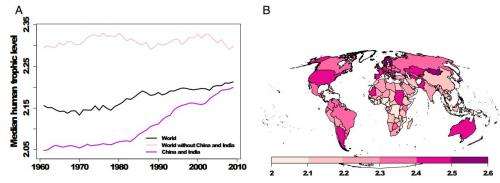December 3, 2013 report
Researchers calculate human trophic level for first time

(Phys.org) —A team of researchers in France, has, for the first time, calculated the Human Trophic Level (HTL)—a number that indicates the proportion of the diet as it relates to the food chain. In their paper, published in Proceedings of the National Academy of Sciences, the researches describe their efforts to combine demography, ecological impacts and socioeconomics to determine the HTL for various groups living around the world, which led them to calculating a worldwide global average.
We human beings like to think of ourselves as living at the top of the food chain—doing so implies we have dominion over all the other plants and animals living on this planet. And while that implied perspective is perhaps correct in one sense, it's not when looked at in its truest biological sense. Organisms at the very top (apex) of the food chain eat only meat—the meat of other predators, that is. Organisms at the bottom, conversely, eat only simple plants. With that definition, in mind, we know we're not going to sit at the top—we eat lots of vegetables, thus we're not going to compete with the likes of tigers or crocodiles.
To put things in perspective, scientists have created a scale that allows for relative comparisons between species, it's called the trophic level and it runs from 1, for base level eaters, to an apex level of 5. What's perhaps most odd about the scale, though, is that nobody's ever thought to find the level for humans. Intrigued, the team in France set out to do just that.
To find out, the researchers turned to the Food and Agricultural Organization (FAO)—it's run by the U.N. and has extensive information regarding the eating habits of people throughout the world. They used the information they were provided to calculate HTL levels for people living in various parts of the world, and then came up with a worldwide average—it's 2.21, about the same as a pig, or an anchovy. That means that meat makes up less than half of our diet (that would be 2.5).
Of course there are variations, vegetarians, for example, would score much lower, whereas some people might subsist mostly on fish, fowl or red meat. Not surprisingly the data obtained by the researchers shows that the more advanced a country becomes, the more meat the people eat, until reaching a plateau.
Knowing the HTL for humans may not cause any changes in the way people eat, but it might just cause some to pause and reflect on our true place in the animal kingdom.
More information: Eating up the world's food web and the human trophic level, Published online before print December 2, 2013, DOI: 10.1073/pnas.1305827110
Abstract
Trophic levels are critical for synthesizing species' diets, depicting energy pathways, understanding food web dynamics and ecosystem functioning, and monitoring ecosystem health. Specifically, trophic levels describe the position of species in a food web, from primary producers to apex predators (range, 1–5). Small differences in trophic level can reflect large differences in diet. Although trophic levels are among the most basic information collected for animals in ecosystems, a human trophic level (HTL) has never been defined. Here, we find a global HTL of 2.21, i.e., the trophic level of anchoveta. This value has increased with time, consistent with the global trend toward diets higher in meat. National HTLs ranging between 2.04 and 2.57 reflect a broad diversity of diet, although cluster analysis of countries with similar dietary trends reveals only five major groups. We find significant links between socio-economic and environmental indicators and global dietary trends. We demonstrate that the HTL is a synthetic index to monitor human diets and provides a baseline to compare diets between countries.
Journal information: Proceedings of the National Academy of Sciences
© 2013 Phys.org
















